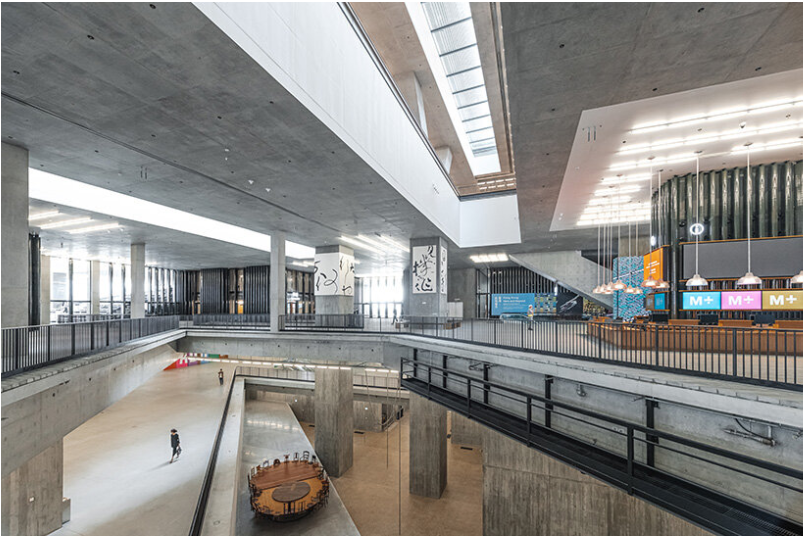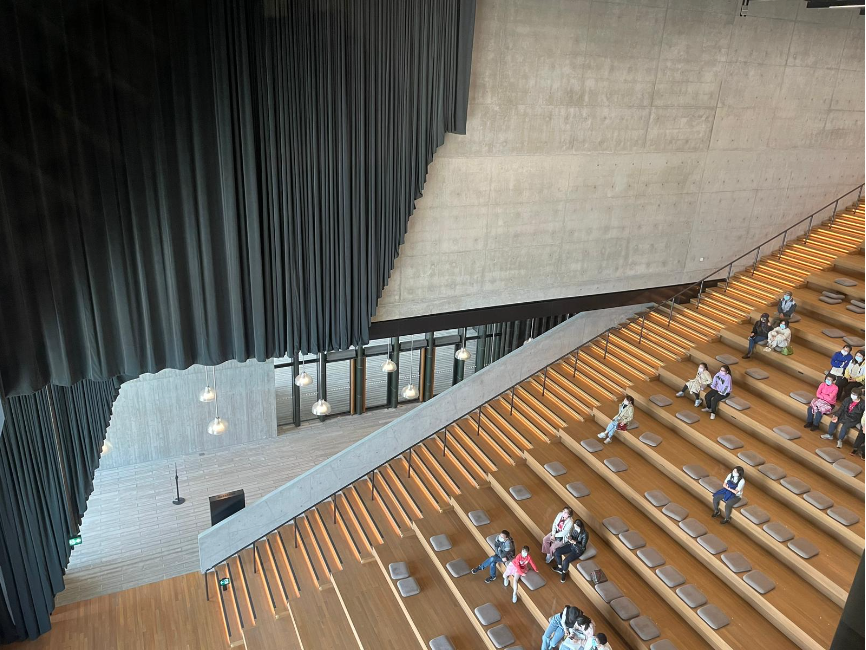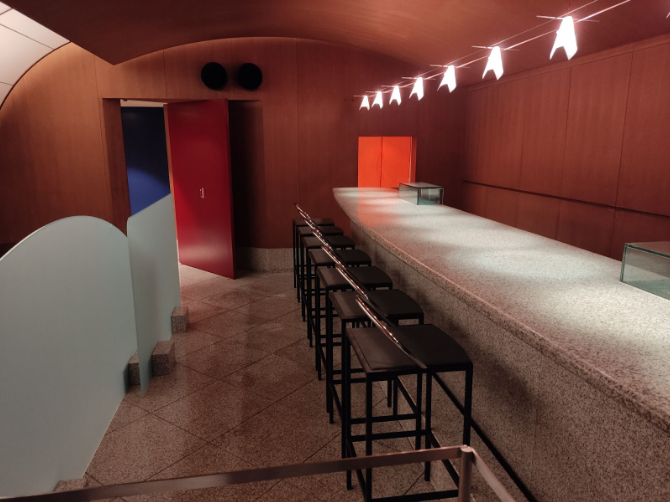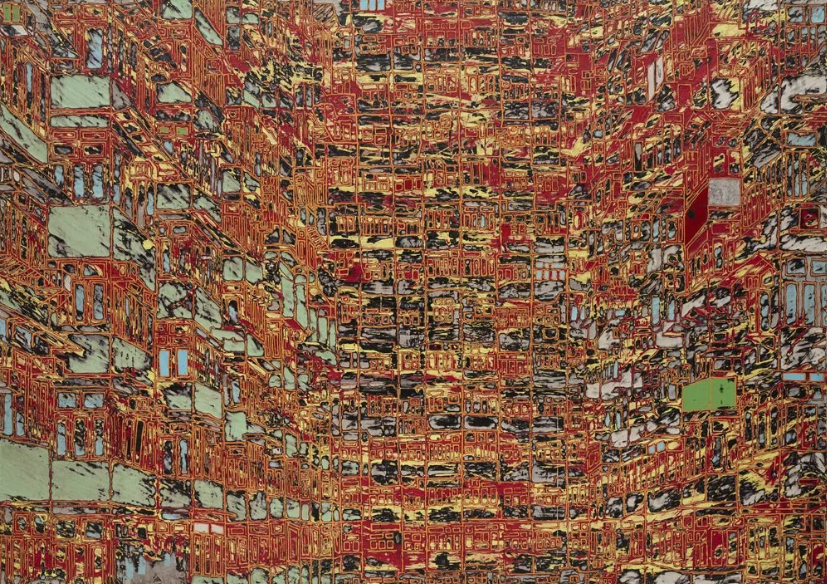Before arriving in Singapore, I had the privileged opportunity to explore Hong Kong’s newly opened M+ museum in its opening week. One of the most expensive and sizeable museums in Asia, M+ stretches across more than 700,000 square feet in West Kowloon, overlooking the beautiful and scenic Victorian Harbour, deeming it a quintessential tourist spot.
However, one step into the museum and the realisation hits: M+’s minimalistic use of space is more than obvious; Exhibition halls and their surroundings are monochromatic and spacious, portraying a very “rudimentary vibe”, possibly to place more emphasis on the artworks themselves.

M+’s minimalist and monochromatic layout
The building was conceptualised and designed by Swiss designers Herzog and de Meuron, who were selected from an international architectural competition in 2013. Herzog and de Meuron evidently focus on spaciousness and structural versatility, while keeping the exterior simple yet attractive. M+’s facade is layered with multiple LED lights, which keeps the museum distinctive and vibrant even after sunset, being a major contributor to Victoria Harbour’s luminous and lively night-time horizon.
Herzog and de Meuron’s selection of construction materials depict a very “industrialised” vibe, as the museum is predominantly built with unpainted concrete and darkly glazed ceramic tiles. However, the museum is filled with skylights, allowing natural light to pass through in the daytime, subsequently making it bright and welcoming for the incoming public at the same time.
Spaciousness in the M+ does not entail the ineffective use of public space however, as M+ holds numeral multi-functional facilities, most recognisable being the Grand Stair, a connector between the upstairs atrium and the outside of the building, and can serve as not only a resting place for fatigued visitors, but as well as an auditorium or cinema for speeches for documentary/movie screenings, where “the city, public and visual culture coincide”, as described by M+ themselves.

The Grand Stair
The significance of M+’s opening truly shines in Hong Kong’s political context: Riots, demonstrations and Chinese censorship, where the museum serves as a cornerstone and icon of artistic freedom, exhibiting many possibly controversial pieces for public viewing, as well as presenting explicit artistic ideologies and messages, which definitely strengthens the overall appeal of the museum to the public.
In terms of the artworks themselves, variety is most exercised in M+’s plethora of galleries. From historical paintings and calligraphy to contemporary, modern graffiti, M+ houses any object or idea that can be classified as artwork, be it controversial or unique. One of the most politically controversial artworks is Ai Weiwei’s “Study of Perspective: Tian’anmen (1997)”, which is a monochromatic photograph of him pointing his middle finger towards the historically notorious location. Despite its simple facade, his photograph serves as a reminder of the democratic values to be empowered in society, and metaphorically “protests” against institutions that tend to hinder and discourage free speech.

Ai Weiwei’s “Study of Perspective: Tian’anmen (1997)”
Another famous artwork, and arguably the most expensive, is M+’s star exhibit: The Kiyotomo Sushi Bar. Imported from Tokyo’s wistful and eccentric Shinbashi district, the sushi bar’s import was with multiple purposes, not only to showcase, but to preserve. Designed by the renowned and legendary Japanese architect, Shiro Kuramata, the 1980s sushi bar was revolutionary and a giant contributor to Japan’s modern architecture and interior design. Experts state that Kuramata’s sushi bar is a prime example of both his innate playfulness and restraint.
The sushi bar strikes every architectural bar perfectly as the bar’s interior perfectly encapsulates the work of a masterful architectural artisan. The floor, walls, ceiling and furniture are placed and designed in a way where Kuramata seizes and orchestrates your visit in a stunning fashion. Kuramata exercises a revolutionary idea; wanting to make the walls and ceiling seem like they were made of a singular, standardised material, like an immaculate sheet of paper floating in empty space.
Kuramata loved creating and integrating illusions and “magical” furnishings into his designs, such as toying and manipulating the size and textures of the restroom and entrance doors, making them seem bigger or smaller than usual, or even making them camouflage into the surrounding walls. With his creativity also came the importance of incorporating Japanese identity into his layout, adding touches of traditional Japanese patterns and materials, such as the cedar veneer on granite floor, in order to form an architectural connection between a contemporary sushi house and a traditional Japanese teahouse.

Shiro Kuramata’s Kiyotomo Sushi Bar
My personal favourite from the M+ Museum is Mark Bradford’s “Circus”, an abstract painting that oversees Hong Kong’s social and political landscape, emphasising on the contrast between socio-economic constraints and an united urban environment. The painting is conceptualised upon numerous layers of architectural drawings and a grid-like abstract rendering of Hong Kong’s public housing, symbolising the density and condensed state of Hong Kong’s urban structure, painting a metaphorically image of confinement and enclosure. However, Bradford juxtaposes this with fiery streaks of red, yellow and green to resemble the ongoing vibrance of the city’s atmosphere, where the people still enjoy and appreciate their own daily lives while adapting with these social conditions. Bradford not only procures an appealing and eye-catching art piece but also sheds light on Hong Kong’s battle against their crisis of public housing.

Mark Bradford’s “Circus”
All in all, as political tensions continue to rise in Hong Kong, M+ serves as a medium for artists to collaborate and collectively portray their unique ideologies without the fear of censorship or political obstacles. Familiarity in artistic techniques is not needed for the enjoyment of the museum’s stunning artworks, and M+ is the perfect destination in Hong Kong to spend your afternoon, whether it be for the view, the atmosphere, or the art.

